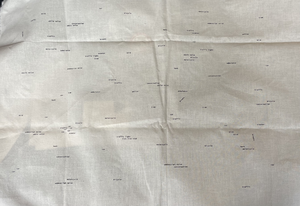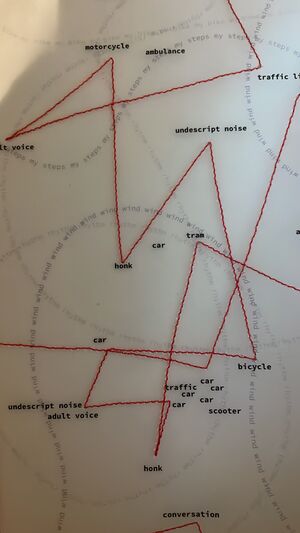User:Anita!/more things: Difference between revisions
No edit summary |
No edit summary |
||
| Line 32: | Line 32: | ||
I also know that I want to incorporate some form of garment construction technique into the final project, but that relates more to the end representation project than the research itself. | I also know that I want to incorporate some form of garment construction technique into the final project, but that relates more to the end representation project than the research itself. | ||
==PMMoMs== | |||
“Sound is pervasive, it spreads out in a space, connecting all bodies that it encounters. It is not an object or an attribute of an object but is generated by the reciprocal relationship between context object and subjects.” Elena Biserna in Going out | |||
===What?=== | |||
A large scale textile soundboard (interactive textile), containing a series of noises collected from public spaces. The soundboard can be played to create different city noise soundscapes, inviting the person playing with it to perform and imagine a path. Different points produce different sounds caught in the city. The person playing has to move and 'dance' because of the distance between the push sensors playing the sounds, enhancing the physicality aspect and embodying the soundscape. | |||
===Why? === | |||
Sound connects. It is not physical but exists so powerfully in space. It identifies places but is not usually thought of or used to describe one, other than the simple ‘noisy’ or ‘silent’. Imagining and playing with mundane sounds, exploring the landscape with no visual aid, to notice and create new imaginary paths. | |||
===Workflow=== | |||
Select and record single sounds from most Rotterdam squares. At least 10 sounds, from thoughout the day. | |||
Record and pick the sounds to be used | |||
Design a soundboard | |||
Program the microcontroller | |||
Sew the circuit for it and connect | |||
Test and play by myself | |||
Adapt based on tests | |||
Test and play with public | |||
Adapt based on tests | |||
Readyyyyy | |||
===Timetable=== | |||
October - recording and listening, early prototyping (drawing circuits, read more on interactive textiles) | |||
November - recording and listening, learn more about interactive textiles, do smaller projects involving them | |||
December - recording and listening, experiment with circuit connections, sewing circuits | |||
January - recording and listening, test on | |||
===Relation to previous practice (two sentences, draw on Text on Practice)=== | |||
Listening, sewing, list making, noticing, moving and playing in public space. | |||
Revision as of 10:33, 20 September 2024
More things is a sub page I would like to put random things that are being worked on that do not relate to other things, kind of like a junk drawer for now.
Continuing the city soundscape
In the end, I ended up with a lot of recordings of solo walks and cycles. What to do with them? I listened to all of them, annotating what sounds I would hear.
These are two examples of the soundscape.
First, I tried on transparency paper, i liked the idea of attempting to create a small sewn zine with overlapping maps, but thinking back, after trying it, i ended up screenprinting this on cotton fabric, as it would allow for me to really use the material to my advantage, placing all the wondering walks and cycles on one singular map, instead of one route per map if that makes sense.
Now I will begin sewing the connections between the sounds, creating many layers.
I also like the idea of somehow also connecting the original audio files, but I am not sure yet of how and if i will do that. Maybe its nice to also just try to imagine the spacing between these sounds, the length of the walks, how close of far they feel, not hearing the sounds, but imagining what we remember they sound like. But lets see
Thinking about research
I want to continue working with sound in the context of public space, that I already know, but how? Listening is something I focused on a lot during the last Special Issue, and it is a topic that I know i want to experiment with more. While listening in the past, I have tried to focus on different aspects of it, for example, listening in a nominal way (yes sound, no sound), which forces you to focus on observing the rhythm of sound.
I also know that I want to incorporate some form of garment construction technique into the final project, but that relates more to the end representation project than the research itself.
PMMoMs
“Sound is pervasive, it spreads out in a space, connecting all bodies that it encounters. It is not an object or an attribute of an object but is generated by the reciprocal relationship between context object and subjects.” Elena Biserna in Going out
What?
A large scale textile soundboard (interactive textile), containing a series of noises collected from public spaces. The soundboard can be played to create different city noise soundscapes, inviting the person playing with it to perform and imagine a path. Different points produce different sounds caught in the city. The person playing has to move and 'dance' because of the distance between the push sensors playing the sounds, enhancing the physicality aspect and embodying the soundscape.
Why?
Sound connects. It is not physical but exists so powerfully in space. It identifies places but is not usually thought of or used to describe one, other than the simple ‘noisy’ or ‘silent’. Imagining and playing with mundane sounds, exploring the landscape with no visual aid, to notice and create new imaginary paths.
Workflow
Select and record single sounds from most Rotterdam squares. At least 10 sounds, from thoughout the day. Record and pick the sounds to be used Design a soundboard Program the microcontroller Sew the circuit for it and connect Test and play by myself Adapt based on tests Test and play with public Adapt based on tests Readyyyyy
Timetable
October - recording and listening, early prototyping (drawing circuits, read more on interactive textiles) November - recording and listening, learn more about interactive textiles, do smaller projects involving them December - recording and listening, experiment with circuit connections, sewing circuits January - recording and listening, test on
Relation to previous practice (two sentences, draw on Text on Practice)
Listening, sewing, list making, noticing, moving and playing in public space.


